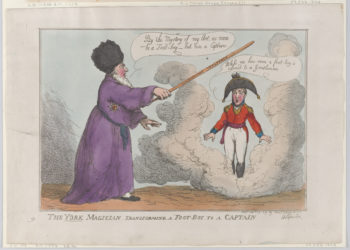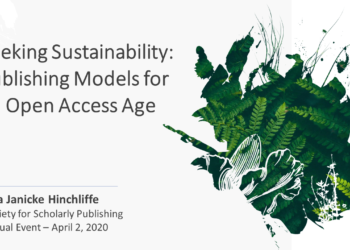Editor’s Note: Today’s post is by Brigitte Shull, Senior Vice President, US and Director of Scholarly Communications R&D at Cambridge University Press
It really wasn’t that long ago that many of us eagerly read Lisa Janicke Hinchliffe’s primer on transformative agreements here in The Scholarly Kitchen and now it seems like news of a major new transformative agreement (TA) is making headlines on a weekly basis. What have we as publishers learned about this transition and how can we help to speed it along with the least amount of disruption?
At Cambridge University Press, we’ve been engaged in a major expansion of our TAs with US institutions. Agreements with 130 institutions came into effect this year with a diverse mix of organizations, including state university systems, liberal arts colleges, and major research universities. These agreements follow the “Read and Publish” model (R&P) we kicked off in the US with the University of California system; repurposing institutions’ existing subscription spend to open up access to important scholarly content and to extend the reach of their researchers’ work. The success this year in the US now gives us real scale — we have over 100 TAs covering 1000 institutes in 30 countries — and a critical mass of customer, author, and stakeholder feedback has given us a much better sense of what we will need to prioritize moving forward.
Yet even as we’ve actively sought to build momentum for change through R&P arrangements, we know that the evolution of TAs is essential to a long-term transition. While there are still many challenges we must solve for collectively, we are focusing our external engagement on four main areas.

Funder mandates should not be the only drivers of change
To enact a wholesale shift to open access (OA), which we believe is in the best interests of the global research ecosystem, we must encourage and facilitate other agents of change beyond the funder mandate. The role of the publisher must evolve and grow to facilitate positive change. Our firm belief remains that we should not wait to react to landmark shifts in government policy, and that proactive effort, principled engagement, and collaborative partnerships can impart positive change now.
There is no mandate for immediate OA publication across all publicly-funded research in the US as there is in parts of Europe. However, as the recent examples of the public access language in the US Innovation and Competition Act and a memoranda from the White House on Research and Development priorities show, there is recognition that making research open extends the impact of that research and the data that underpins it. Regardless of funder mandates, the US is a major global producer of research and is therefore vital to any genuine global move to an open access world.
Stakeholders’ commitment to redistributing and reallocating funding and the collaboration around this work should be the driver of change. This involves institutions, funders, publishers, and other players and needs to cast a wide net. For institutions, the leadership and vision of OA 2020 created a willing set of early adopters to use library subscription spending to support the transformation to open. Subsequently, the OA 2020 Community of Practice and the recent white paper ‘APCs in the Wild’ have explored this transition and how multiple sources of funding should be brought together more effectively. We hope that more institutions trial evolved and/or new models and achieve better alignment with their own principles of openness and sustainability.
The absence of a mandate in the US does make transitioning output to OA materially more challenging. To succeed, it requires a momentum generated by multiple parties, which thereby presents an opportunity for true cooperation and long-term success.
Increased scale must come with better use of resources
TAs are new and understandably have created work for authors, institutions, and publishers. If we are moving to a world where the library plays an integral part in activating open access publishing within an institutional setting, we must seriously work to simplify the way they instigate, manage, and assess investments in these critical researcher services. For some institutions, negotiating a novel agreement is an initial hurdle. For others, the long-term question of management is a concern without a dedicated scholarly communications member of staff.
Cost is an ever-present concern, more so now than ever before. At Cambridge, our priority has been to offer affordable options to enable uncapped open access publishing, and the rapid uptake and positive feedback we received in the US shows our approach is moving us in the right direction. But we know, and continue to hear, that many libraries cannot afford similar agreements with every publisher, and that cost continues to be prohibitive to the proliferation of open access agreements in the US. We were surprised to see control measures manifest within our own uncapped publishing agreements — some institutions place additional eligibility checks to effectively limit the number of articles they will publish OA, despite there being no need to do so within the context of their Cambridge license. What this has taught us is that there is an emerging tension between making positive scholarly communications decisions and managing expenditure. We see responsible selling that enables true, value-driven publishing service relationships as essential for institutions to be able to navigate this growing problem.
In August 2021, Louise Russell from Tutton Russell Consulting, conducted an Open Access Workflow survey across research publishers on our behalf. While 81% of respondents have developed/are developing homegrown solutions to support the OA workflow, there was broad recognition that a coordinated approach on topics like consolidating metadata at the article level through collaboration like the OA Switchboard (or equivalent), greater automation, and establishing industry-wide best practice on reporting will be required. There was also consensus that we must make OA publishing as easy and pain-free for authors as possible. Interestingly, comments from the free-text questions also showed that minimizing the visibility of the infrastructure for OA publishing for authors is increasingly seen as the best path forward.
Equity and diversity must be supported in new ways
Open access models need to be careful not to move the barrier from access to publishing. Alison Mudditt has outlined here in the Scholarly Kitchen the risks of researcher exclusion of the APC-based models of transformation. Key industry initiatives focused on addressing equity in scholarly communications such as Research4Life are also grappling with the changes the OA movement brings but are largely focused on the use of APC waivers for low and middle income countries. This potentially leaves a wide swath of researchers without access to publication payments via a funder or an institution. We need to evolve past the strictures of current TAs to include support for new kinds of open access publishing venues and non-research content that provides huge value to the research community. New models need to safeguard universal author interests by building in guarantees for inclusion of all researchers and all content types via innovative financial support systems. How the next generation of transformative agreements addresses access to publishing needs to move to the forefront of our cross-stakeholder dialogue now while there is still enough flex in the transition to address such an important issue.
Open is a means, not an end
Finally, we must communicate the benefits of OA to researchers themselves, to convince them that OA leads to a greater awareness and use of their work. There are authors eligible to publish OA still declining to do so, and follow up outreach shows that many of those declining were doing so based on misperceptions. We must also translate these benefits in a way that is relevant to the types of reporting authors make to funders, administrations and research officers. This has been and continues to be a key priority for us at Cambridge.
The research community has taken significant strides in the adoption of open research in the last few years. Does CUP’s perspective on these issues resonate with other major scholarly publishers? And how do funders, research institutes, and, of course, researchers view these elements of this transition? We are looking forward to working with the entire community to ensure that all publicly funded published research is accessible to all.
Discussion
6 Thoughts on "Guest Post – Transforming the Transformative Agreement"
This post looks hopefully toward the future of OA, but as much of the literature does, focuses ists attention and recommendations for change on journal, not monograph, publishing. In that respect it mirrors the development of the OA movement overall, which began in earnest with the Budapest Initiative in 2001. When I was president of the AAUP (now AUP) in 2007/8, I made an effort to redirect some of that attention toward monograph publishing in OA mode and the challenges it faced, by drafting the AAUP Statement on Open Access (July 2007). Progress since then has been painfully slow, especially in the US where there is yet only one university press, at Amherst, that operates fully as an OA monograph publisher in the humanities. The National Academies Press pioneered the efforts beginning in the early 1990s, and the Committee on Institutional Cooperation (now the Big Ten Alliance) presented a proposal to the Mellon Foundation in 1996 for an experiment in epublishing of monographs, which alas did not get funded and was then dropped. At Penn State, together with the Libraries, we launched the Office of Digital Scholarly Publishing in 2005 offering a number of OA monograph series including one on Romance Studies. I write about this program and ists origins in “Open-Access Monograph Publishing and the Origins of the ODSP” (Journal of Scholarly Publishing, accessible OA through Penn State’s IR, ScholarSphere. We need TAs for monographs as well. Lets’s hope we will see more progress in the years to come than we have in the past twenty.
That progress is coming, Sanford. For example, see Fund to Mission from the University of Michigan Press (https://www.publishing.umich.edu/features/fund-to-mission) and Direct to Open from MIT Press (https://mitpress.mit.edu/blog/mit-press-launches-direct-open). There’s also the TOME initiative (https://www.openmonographs.org/). My institution (Emory University) participates in TOME, and six of our faculty members have published open access monographs (https://books.openmonographs.org/Emory) through a Mellon-funded grant to Emory and TOME. Granted, these numbers are small, but they are growing.
Thanks very much for reading! As Jody notes below, there is still a lot of experimentation in the open books landscape. At Cambridge, we recently launched Flip It Open and are looking forward to learning more about how we can affect open transformation for books as well.
I am curious how TAs either protect or erode society partners revenue streams from their journals? Are there problems meeting those financial commitments to those societies under these agreements? How does the math change with that? I think moving more and more to OA has a number of unintended consequences that are not often explored.
Thanks for reading! The answer to this question may vary across publishers but we’ve invested a huge amount of work to update our allocation model to manage this transition for societies. There isn’t a 1-to-1 ratio of transition of income though of course and we’ve had to be very careful about sustainability. We believe that embracing transformative agreements is the right move since the disruptions to the business models around traditional subscriptions and collection sales, i.e. pressure on library budgets, open access, funder policy changes, etc, meant that doing nothing would have resulted in an erosion of society revenue streams.
Thank you. I think an issue though is in the past if Institution X subscribed to your journal then they paid Y to do so. Yes, there are discounts, etc. but basically you were selling a product and you could report back more or less what was being charged for the product. But with TAs the math suddenly got way more complicated. If a journal charges a certain amount for OA but an author cites a TA when publishing in the journal does the journal still get that same OA amount put on its books? A smaller amount, how small? So while a journal may have a retail price for OA shown to the world, the TAs might really change that making it impossible for the journal to track its own revenue (because the authors from one place get 100% off, another get 50% off, another 15% off and so on). If a journal then transitions to complete OA it becomes really hard to know how many papers a journal needs to accept to generate the same revenue. I realize you cannot really answer these specific questions but I thought them worth raising as examples of what people are really concerned about.



